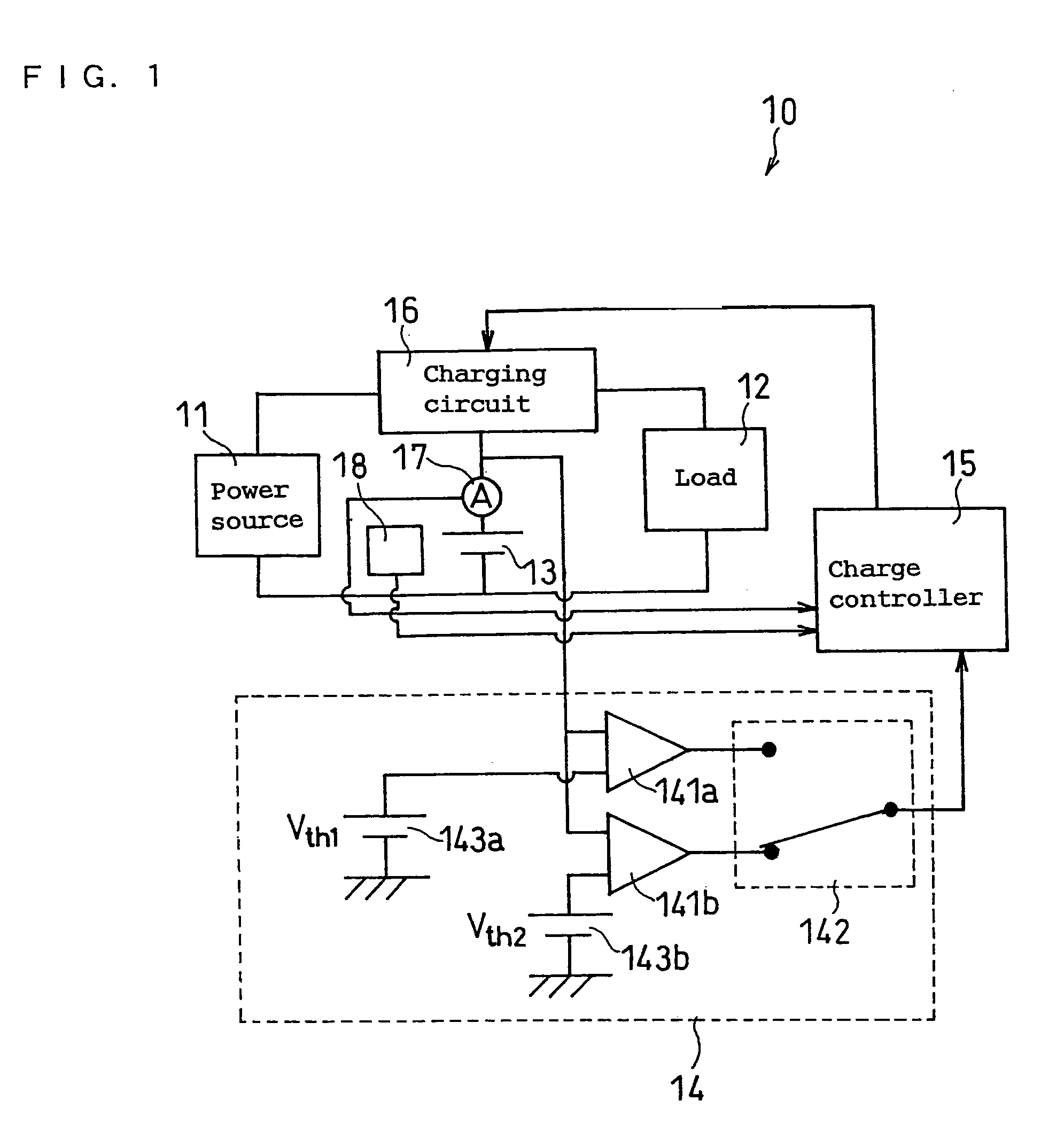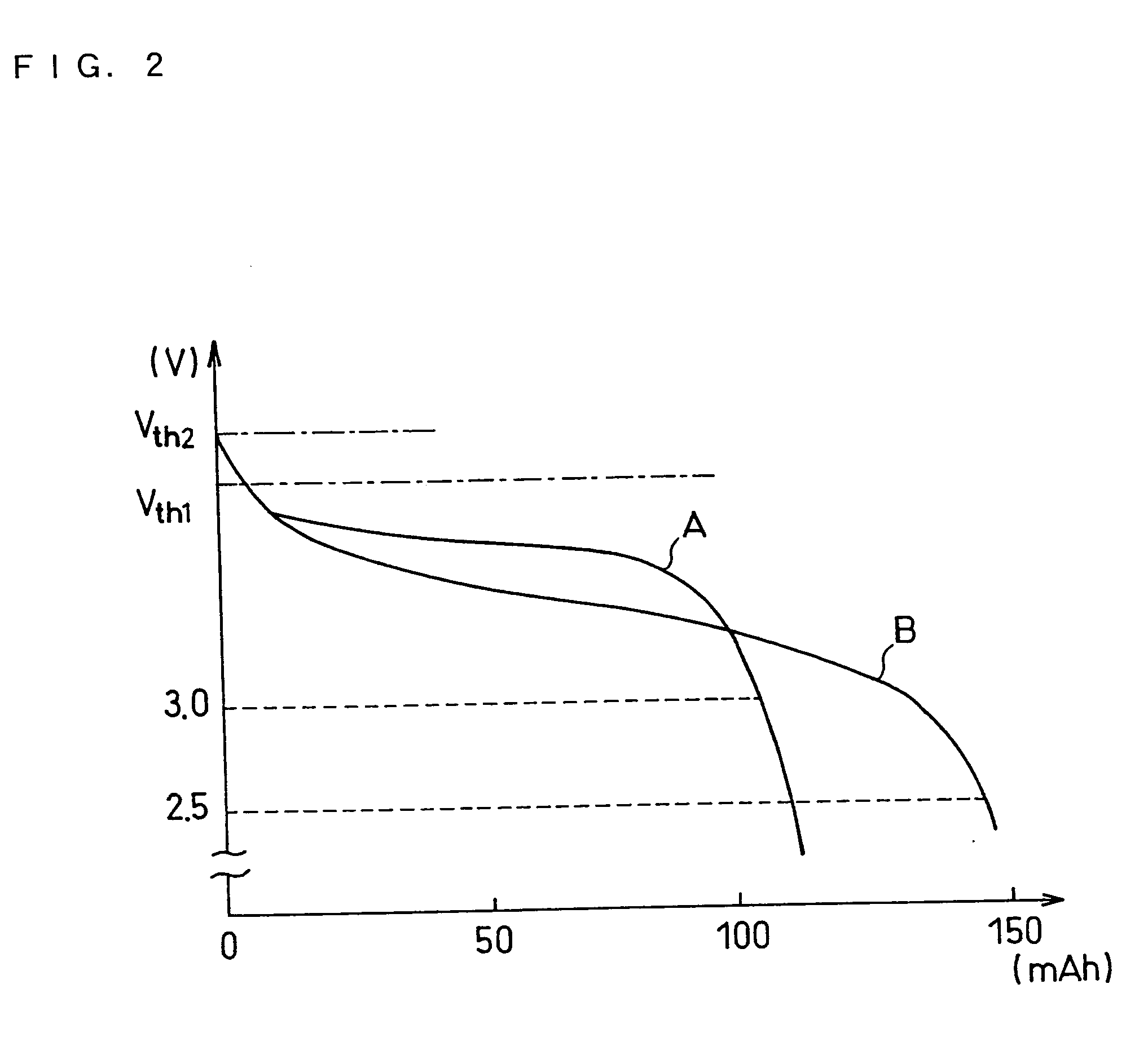Charger for lithium secondary battery and electronic apparatus including charger
a lithium secondary battery and charger technology, applied in the direction of battery/fuel cell control arrangement, electric devices, cell components, etc., can solve the problems of cycle life deterioration, battery capacity to drop significantly upon full charge, and end-of-charge voltage determination
- Summary
- Abstract
- Description
- Claims
- Application Information
AI Technical Summary
Benefits of technology
Problems solved by technology
Method used
Image
Examples
embodiment 1
[0029]FIG. 1 is a schematic diagram of an electronic apparatus equipped with a charger for a secondary battery that includes a positive electrode, a negative electrode including lithium-containing silicon represented by the composition formula LixSi, and an electrolyte.
[0030] An electronic apparatus 10 as illustrated in FIG. 1 includes a load 12, a secondary battery 13, and a charger. The charger includes a voltage detector 14, a charge controller 15, and a charging circuit 16.
[0031] For example, the portable electronic apparatus 10 is driven when electric power is supplied from the secondary battery 13 to the load 12.
[0032] In this embodiment, the secondary battery 13 is charged with power supplied from a power source 11 through the charging circuit 16.
[0033] Examples of the power source 11 include power supply means, such as a fuel cell, a solar battery, and a generator which an engine is equipped with. Also, power may be supplied from utility power through an AC adapter.
[003...
embodiment 2
[0066]FIG. 3 is a schematic diagram of an electronic apparatus equipped with a charger, in which the charge controller has three threshold values and the voltage detector accordingly has three voltage comparators.
[0067] In this embodiment, an electronic apparatus 30 includes a load 32, a secondary battery 33, and a charger. The charger includes a voltage detector 34, a charge controller 35, and a charging circuit 36.
[0068] In the same manner as in Embodiment 1, the electronic apparatus 30 is driven when electric power is supplied from the secondary battery 33 to the load 32. The secondary battery 33 is charged with power supplied from a power source 31 through the charging circuit 36.
[0069] This embodiment is the same as Embodiment 1, except that the electronic apparatus 30 is configured such that the charge controller 35 has three threshold values of a first threshold value xth1, a second threshold value xth2, and a third threshold value xth3, and that the voltage detector 34 ha...
embodiment 3
[0077] This embodiment describes the case where the charge controller has at least one settable threshold value including a first threshold value and the first threshold value is 2.33 or less.
[0078] In this case, at least one voltage including the voltage corresponding to the first threshold value is set as a threshold voltage in the voltage detector.
[0079] The other components than the voltage detector are the same as those in Embodiment 1.
[0080] As described above, by setting a first threshold value of 2.33 or less and charging the secondary battery such that the molar ratio x of Li in lithium-containing silicon included therein reaches the first threshold value, the secondary battery can be charged such that it has a high capacity and a long cycle life.
[0081] Also, for example, when the charge controller has another threshold value of less than 2.33 other than the first threshold value, the secondary battery can be charged such that it has a longer cycle life.
[0082] In this ...
PUM
 Login to View More
Login to View More Abstract
Description
Claims
Application Information
 Login to View More
Login to View More - R&D
- Intellectual Property
- Life Sciences
- Materials
- Tech Scout
- Unparalleled Data Quality
- Higher Quality Content
- 60% Fewer Hallucinations
Browse by: Latest US Patents, China's latest patents, Technical Efficacy Thesaurus, Application Domain, Technology Topic, Popular Technical Reports.
© 2025 PatSnap. All rights reserved.Legal|Privacy policy|Modern Slavery Act Transparency Statement|Sitemap|About US| Contact US: help@patsnap.com



